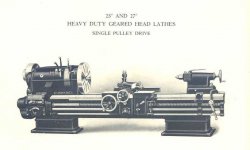Dr. Hillbilly
Aluminum
- Joined
- Dec 6, 2019
- Location
- Oregonia, Ohio
That was intended to be "Resurrection of LeBlond 27" Heavy, but the spelling checker bit me again!
Some of you were following the "FS Big LeBlond" thread, and this is the next phase of it as I am purchasing the lathe and must start planning it's return to life.
If you missed the previous thread, it once looked like the long-bed version of this

And now it looks like this

Here is the preceding cone-head version in 1911

Here is the following single-speed belt drive version in 1920 something

Mine was built in 1919
The swing is 27"
It has the extended bed casting for 8" between centers
Weighs 9600 lb without tooling
Has 4 speeds in the headstock, a back-gear, and originally had a 3 speed (500,1000,and 1500 rpm) DC (?) motor for 24 speeds
It now has a retrofitted single speed 3-phase motor with 4-speed gearbox
I have no fantasy of making it a museum piece, but want to get it running.
Everything is nearly frozen, and can be moved only with considerable effort.
I may simplify the task by setting it up for single speed belt drive from a line-shaft or electric motor as LeBlond did in the 20s. If I run the input shaft at the 1500 rpm used as top speed for the original DC motor I have 8 speeds rather than 24 and my minimum spindle speed is increased from 5 rpm to 15 rpm, but I think I can live with that. I really did not need 5,000 ft. lb. of torque anyway! Although with that much torque I could let the motor loosen up the spindle (or break the spindle).
So the first of many questions are:
1. What is the best method to free things up? Soak in a mix of used oil and kerosene?
2. Any tricks to pushing rust off of lead-screws?
Some of you were following the "FS Big LeBlond" thread, and this is the next phase of it as I am purchasing the lathe and must start planning it's return to life.
If you missed the previous thread, it once looked like the long-bed version of this

And now it looks like this

Here is the preceding cone-head version in 1911

Here is the following single-speed belt drive version in 1920 something

Mine was built in 1919
The swing is 27"
It has the extended bed casting for 8" between centers
Weighs 9600 lb without tooling
Has 4 speeds in the headstock, a back-gear, and originally had a 3 speed (500,1000,and 1500 rpm) DC (?) motor for 24 speeds
It now has a retrofitted single speed 3-phase motor with 4-speed gearbox
I have no fantasy of making it a museum piece, but want to get it running.
Everything is nearly frozen, and can be moved only with considerable effort.
I may simplify the task by setting it up for single speed belt drive from a line-shaft or electric motor as LeBlond did in the 20s. If I run the input shaft at the 1500 rpm used as top speed for the original DC motor I have 8 speeds rather than 24 and my minimum spindle speed is increased from 5 rpm to 15 rpm, but I think I can live with that. I really did not need 5,000 ft. lb. of torque anyway! Although with that much torque I could let the motor loosen up the spindle (or break the spindle).
So the first of many questions are:
1. What is the best method to free things up? Soak in a mix of used oil and kerosene?
2. Any tricks to pushing rust off of lead-screws?




